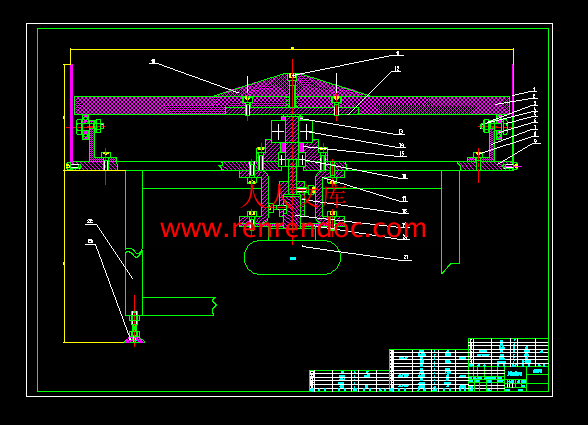EG-6203四通道超声波轴承清洗机送料机构设计
45页 15000字数+说明书+开题报告+任务书+14张CAD图纸
EG-6203四通道超声波轴承清洗机送料机构设计论文.doc
上料圆板A4.dwg
上料圆盘A1.dwg
上料盘装配图A0.dwg
传动轴A4.dwg
偏心轴A4.dwg
圆台A4.dwg
底脚A4.dwg
挡料板A2.dwg
支架A4.dwg
特制垫片A4.dwg
盘轴座A4.dwg
相关资料.doc
计划周记进度检查表-5.xls
连接板A2.dwg
连接轴A1.dwg
连轴套A4.dwg
EG-6203四通道超声波轴承清洗机送料机构设计开题报告.doc
任务书.doc
摘 要
随着市场对产品质量要求的日益严格和国际上对环保要求力度的加强,我国精密零件清洗工业受到极大的挑战,长期在精密零件清洗领域占据主导地位的ODS类清洗工艺由于破坏臭氧层而被禁止使用,作为代替品出现的一些氯代烃清洗剂,水基清洗剂和碳氢溶剂由于分别具有毒性,水处理繁琐,清洗效果较差以及不易干燥,安全性较差等缺点。阻碍了国内清洗工业的发展。
本文主要对EG-6203型的轴承的生产中的清洗的工序的清洗设备的设计,它也是利用当今的科技超声波清洗代替了原来的机械清洗,工作过程如下:将要清洗的轴承放入自动上料机构的上料圆盘,上料圆盘在减速电机的带动下旋转,通过离心力的作用,轴承在挡料板的作用下,推料进入导归轨,再依次进入推料气缸的位置,在感应接触开关控制气缸在送料之前,上料台的导轨下有退磁器将轴承的磁性去掉,然后进入超声波清洗槽,然后是甩干槽,最后进入注脂包装生产线。本次设计的EG-6203型轴承超声波清洗机是PLC控制的全自动超声波清洗机。其具备了自动送料、自动感应退磁、自动记数、全程清洗喷淋风干、全程监控报警的功能。为现在的轴承制造业大大提高效率,使产品合格率大大提升。
关键词:超声波;轴承清洗机;上料机构;自动控制。
目 录
摘 要III
AbstractIV
目 录V
1 绪论1
1.1 课题来源1
1.2 课题意义1
1.2.1 超声波清洗的特点1
1.2.2 现代超声波在轴承清洗中的发展趋势2
1.3超声波的分类及其主要工作器件2
1.3.1 通用超声波清洗机3
1.3.2 超声清洗机用的超声波发生器3
1.3.3 专用超声波清洗机5
2 总体方案设计7
2.1 总体方案设计的综述7
2.2 超声波发生器8
2.2.1 超声波发生器的简述8
2.2.2 超声波发生器的原理8
2.3 清洗槽8
2.4 自动送料机构10
3 清洗槽的具体设计12
3.1 导轨的结构12
3.2 清洗油泵、风机的设计12
3.3 油喷针和风喷嘴设计14
4 自动送料机构的设计15
4.1原理、结构及工作过程15
4.2轴的设计及校核15
4.3轴承的设计和校核18
4.4挡料板的设计20
4.5齿轮的校核20
4.5.1 齿轮的失效形成20
4.5.2 齿轮设计的要求21
4.5.3 齿轮的设计及校核21
5 自动控制电路25
5.1 PLC简介25
5.1.1 下列为I/O分配表26
5.1.2 下列为本设计的程序符号注释表27
5.1.3 人机界面控制30
5.1.4 本程序的梯形图30
6 结论与展望32
6.1结论32
6.2不足之处及未来展望32
致 谢33
参考文献34
需求数量变大。
1.2 课题意义
在市场经济的环境下,对产品质量要求越来越高。为保证产品质量,许多企业在产品生产过程中,将采用清洗工艺来提高产品质量,为企业创造良好的经济效益。当前在一些工业产品生产过程中,超声波清洗的优点是价格经济,洗净效果良好,特别是在国际社会对于环境要求更加苛刻的条件下,有利于环保。超声清洗机可以应用于清洗体形大小不一,形状复杂,清洁度要求高的工件。例如可用于清洗手机零件、飞机零件、电脑零件、动车发动机零件、精密轴承零件、花键、垫片、车刀、锯片、钻石、注射器和各种显微镜镜头等;还可以用于清洗电路板、晶片及超导器件、电子显象管内的精密零件、电磁性元件、硅片、插座、相关的核材料、电极引线等电子类产品。
我国加入WTO后,国外越来越多的厂家已经落户中国,产品质量竞争和静音轴承的开发、应用也势在必行,提高轴承洁净度水平也可促进和改善现有轴承的清洗技术和工艺管理水平,同时也是提高我国轴承行业国际竞争力的有效手段之一。
1.2.1 超声波清洗的特点
超声波清洗与其它清洗相比具有洗净率高、残留物少,清洗时间短,清洗效果好,凡是能被液体浸到的被清洗件,超声对它都有清洗作用。不受清洗件表面形状限止,例深孔、狭缝、凹槽。都能得到清洗。由于超声波发生器采用D类工作放大,换能器的电声效率高,因此超声清洗具有高效节能。它是一种真正高速、高质量、能易实现自动化的清洗技术。若清洗剂采用非ODS清洗剂则具有绿色环保清洗作用。超声清洗对玻璃、金属等反射强的物体其清洗效果好,而不适宜纺织品、多孔泡沫塑料、橡胶制品等声吸收强的材料。
电子材料加工成型后的清洗:如晶片、硅片、压电陶瓷片等电子材料是供给元器件厂家的产品,其产品出厂前必须清洗,特别是做出口业务的厂家,其产品清洗成为一大难题,超声波清洗是最有效的途径。以下是超声波清洗技术的具体应用范围:
(1) 机械行业:防锈油脂的去除;量具的清洗;机械零部件的除油除锈;发动机、化油器及汽车零件的清洗;过滤器、滤网的疏通清洗等。
(2) 表面处理行业:电镀前的除油除锈;离子镀前清洗;磷化处理;清除积炭;清除氧化皮;清除抛光膏;金属工件表面活化处理等。
(3) 仪器仪表行业:精密零件的高清洁度装配前的清洗等。
(4) 电子行业:印刷线路板除松香、焊斑;高压触点等机械电子零件的清洗等。
(5) 医疗行业:医疗器械的清洗、消毒、杀菌、实验器皿的清洗等。
(6) 半导体行业:半导体晶片的高清洁度清洗。
(7) 钟表首、饰行业:清除油泥、灰尘、氧化层、抛光膏等。
(8) 化学、生物行业:实验器皿的清洗、除垢。
(9) 光学行业:光学器件的除油、除汗、清灰等。
(10) 纺织印染行业:清洗纺织锭子、喷丝板等。
(11) 石油化工行业:金属滤网的清洗疏通、化工容器、交换器的清洗等。

 川公网安备: 51019002004831号
川公网安备: 51019002004831号